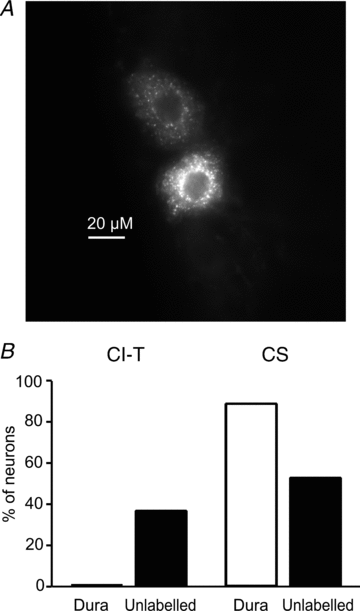Trigeminal ganglion neuron subtype-specific alterations of Ca(V)2.1 calcium current and excitability in a Cacna1a mouse model of migraine
- PMID: 22005682
- PMCID: PMC3249056
- DOI: 10.1113/jphysiol.2011.220533
Trigeminal ganglion neuron subtype-specific alterations of Ca(V)2.1 calcium current and excitability in a Cacna1a mouse model of migraine
Abstract
Familial hemiplegic migraine type-1 (FHM1), a monogenic subtype of migraine with aura, is caused by gain-of-function mutations in Ca(V)2.1 (P/Q-type) calcium channels. The consequences of FHM1 mutations on the trigeminovascular pathway that generates migraine headache remain largely unexplored. Here we studied the calcium currents and excitability properties of two subpopulations of small-diameter trigeminal ganglion (TG) neurons from adult wild-type (WT) and R192Q FHM1 knockin (KI) mice: capsaicin-sensitive neurons without T-type calcium currents (CS) and capsaicin-insensitive neurons characterized by the expression of T-type calcium currents (CI-T). Small TG neurons retrogradely labelled from the dura are mostly CS neurons, while CI-T neurons were not present in the labelled population. CS and CI-T neurons express Ca(V)2.1 channels with different activation properties, and the Ca(V)2.1 channels are differently affected by the FHM1 mutation in the two TG neuron subtypes. In CI-T neurons from FHM1 KI mice there was a larger P/Q-type current density following mild depolarizations, a larger action potential (AP)-evoked calcium current and a longer AP duration when compared to CI-T neurons from WT mice. In striking contrast, the P/Q-type current density, voltage dependence and kinetics were not altered by the FHM1 mutation in CS neurons. The excitability properties of mutant CS neurons were also unaltered. Congruently, the FHM1 mutation did not alter depolarization-evoked CGRP release from the dura mater, while CGRP release from the trigeminal ganglion was larger in KI compared to WT mice. Our findings suggest that the facilitation of peripheral mechanisms of CGRP action, such as dural vasodilatation and nociceptor sensitization at the meninges, does not contribute to the generation of headache in FHM1.
Figures








Comment in
-
Unequal gains of function are a headache for migraine mechanisms.J Physiol. 2012 Jan 1;590(1):1-2. doi: 10.1113/jphysiol.2011.223545. J Physiol. 2012. PMID: 22210282 Free PMC article. No abstract available.
Similar articles
-
A hyperexcitability phenotype in mouse trigeminal sensory neurons expressing the R192Q Cacna1a missense mutation of familial hemiplegic migraine type-1.Neuroscience. 2014 Apr 25;266:244-54. doi: 10.1016/j.neuroscience.2014.02.020. Epub 2014 Feb 27. Neuroscience. 2014. PMID: 24583041
-
Trigeminovascular calcitonin gene-related peptide function in Cacna1a R192Q-mutated knock-in mice.J Cereb Blood Flow Metab. 2019 Apr;39(4):718-729. doi: 10.1177/0271678X17725673. Epub 2017 Aug 9. J Cereb Blood Flow Metab. 2019. PMID: 28792272 Free PMC article.
-
Immunohistochemical characterization of calcitonin gene-related peptide in the trigeminal system of the familial hemiplegic migraine 1 knock-in mouse.Cephalalgia. 2011 Oct;31(13):1368-80. doi: 10.1177/0333102411418847. Epub 2011 Sep 5. Cephalalgia. 2011. PMID: 21893556
-
Calcium channels and migraine.Biochim Biophys Acta. 2013 Jul;1828(7):1655-65. doi: 10.1016/j.bbamem.2012.11.012. Epub 2012 Nov 16. Biochim Biophys Acta. 2013. PMID: 23165010 Review.
-
Insights into migraine mechanisms and CaV2.1 calcium channel function from mouse models of familial hemiplegic migraine.J Physiol. 2010 Jun 1;588(Pt 11):1871-8. doi: 10.1113/jphysiol.2010.188003. Epub 2010 Mar 1. J Physiol. 2010. PMID: 20194127 Free PMC article. Review.
Cited by
-
N-Methyl-d-aspartate receptor open-channel blockers memantine and magnesium modulate nociceptive trigeminovascular neurotransmission in rats.Eur J Neurosci. 2019 Sep;50(5):2847-2859. doi: 10.1111/ejn.14423. Epub 2019 Jun 3. Eur J Neurosci. 2019. PMID: 31009120 Free PMC article.
-
Overexpressed Na V 1.7 Channels Confer Hyperexcitability to in vitro Trigeminal Sensory Neurons of Ca V 2.1 Mutant Hemiplegic Migraine Mice.Front Cell Neurosci. 2021 May 25;15:640709. doi: 10.3389/fncel.2021.640709. eCollection 2021. Front Cell Neurosci. 2021. PMID: 34113237 Free PMC article.
-
Unequal gains of function are a headache for migraine mechanisms.J Physiol. 2012 Jan 1;590(1):1-2. doi: 10.1113/jphysiol.2011.223545. J Physiol. 2012. PMID: 22210282 Free PMC article. No abstract available.
-
Effects of familial hemiplegic migraine type 1 mutation T666M on voltage-gated calcium channel activities in trigeminal ganglion neurons.J Neurophysiol. 2012 Mar;107(6):1666-80. doi: 10.1152/jn.00551.2011. Epub 2011 Dec 21. J Neurophysiol. 2012. PMID: 22190617 Free PMC article.
-
Models of Trigeminal Activation: Is There an Animal Model of Migraine?Brain Sci. 2024 Mar 27;14(4):317. doi: 10.3390/brainsci14040317. Brain Sci. 2024. PMID: 38671969 Free PMC article. Review.
References
-
- Adams PJ, Garcia E, David LS, Mulatz KJ, Spacey SD, Snutch TP. CaV2.1 P/Q-type calcium channel alternative splicing affects the functional impact of familial hemiplegic migraine mutations: implications for calcium channelopathies. Channels (Austin) 2009;3:110–121. - PubMed
-
- Ayata C. Spreading depression: from serendipity to targeted therapy in migraine prophylaxis. Cephalalgia. 2009;29:1095–1114. - PubMed
Publication types
MeSH terms
Substances
Supplementary concepts
Grants and funding
LinkOut - more resources
Full Text Sources
Medical
Molecular Biology Databases
Research Materials
Miscellaneous

